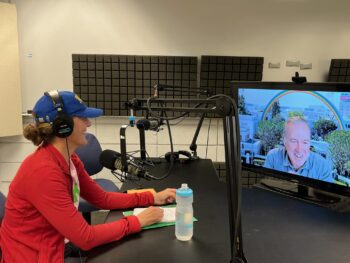Think small. Act locally. Start at home. These phrases may not seem to reflect as “grand” a climate solution as the world clearly needs, but bear with me. Some of today’s most influential climate leaders are, in fact, focusing on their closer-to-home work. So, it’s worth understanding why this may be. A recent conversation I had with Aimee Christensen got me thinking…
In her keynote address for the annual Seattle Climate Solutions event, Christensen spoke of her new priority: the development of the Sun Valley Institute, a Center for Resilience (SVI), described on its website as “a center for policy leadership, public engagement and targeted investments to advance the economic prosperity, environmental protection and human well-being in its home community of Idaho’s Wood River Valley and beyond.”
This globally recognized climate leading influencer , through SVI, is now pursuing very local work, but with much broader impact expected and pursued. Christensen talks about it as a “petri dish,” and suggests that tending to more local, community resilience is the way that many existing climate-focused organizations, businesses and governments can now best contribute to the global issue.
Study Small. Scale Up.
While big announcements and global agreements clearly rally the masses at key moments, the actions necessary to reach those announced goals can get much less notice. It turns out that it may be in these quieter, more place-based steps that exciting ideas and innovations can be tested, fresh alliances can form and banks of new resources can develop. The milestone of COP21 makes this sort of leadership now more important than ever.
As we talked, Christensen pointed out that up until the negotiations leading to the Paris Agreement, climate leaders had been most focused on making the economic case for why countries should take climate action – at all. As she put it: “It was very much a battle of who would act and who wouldn’t, assuming action was an environmental cost, instead of an environmental benefit.”
In the past couple of years, however, this argument has significantly shifted. Notes Christensen, “This is both because the economics of climate mitigation have improved dramatically – thanks to rapidly falling solar and wind prices, increasing proof of attractive returns from energy efficiency, introduction of new business models and technologies – and because of greater realization of the massive costs of inaction seen in devastating storms, heat waves, and the like.”
Nations are now competing for the economic opportunity of the low carbon economy and are investing in resilience to mitigate the impacts. Global governmental, NGO and corporate leaders are all moving forward with climate action plans, and local leaders appear to be leading he way in energy, enthusiasm and collaborative innovation.
Cities Lead. Others Learn.
Cities may be the most noticeable in pursuing this new form of petri dish-scale leadership. Mayors (and very noticeably, one former mayor – Michael Bloomberg) are now working with businesses and foundations to collaborate on how to reach climate goals. At the recent Climate Action 2016 conference where many such leaders gathered, Christensen saw “a real comfort in broadening the collaboration outside city operations to partner with innovators in business and nonprofits, because we are past negotiation and into the action stage and expertise is sought from all possible sources.” In her mind this is critical to enable success. “We can learn from those who are pioneering, and take collaborative action where it can benefit all, whether from joint purchasing to reduce prices, or regional infrastructure exchanges to mobilize financial resources.”
A November 2014 charrette hosted by Matt Petersen the Chief Sustainability Officer for Los Angeles Mayor Eric Garcetti exemplified this type of leadership, according to Christensen, who participated. For this convening, Petersen and his team invited and learned from the efforts of Chief Sustainability Officers from cities that included Philadelphia and Chicago. Those gathered then worked out ways they might be able to collaborate and continue the conversation. What happened at that charrette was “about determining the priorities for Los Angeles, such as addressing water risks, reducing greenhouse gas emissions, finding transportation solutions, and hearing from other cities about how they are meeting these challenges.” Christensen saw it as creating a very collaborative environment, with forward-moving discussion that developed with a “very much arm in arm, and how are we going to get this done” mindset.
To advance this, Christensen sees some of the bigger North American cities attracting incredible sustainability leaders who approach their tasks in similar ways to Petersen – a Mayor wishes to lead, a CSO is hired, broad stakeholder engagement is undertaken, and learning and experimentation begin. With success comes more and scaled action. Regional, state, national and global networks of city leaders help accelerate impact with shared solutions, and also help provide security in not leading alone.
Small Towns. Big Leadership.
In Sun Valley more specifically, the petri dish to innovate, test and scale is enabled by a combination of local leadership from city and county officials as well as a broad recognition by many in the community that climate change is increasingly threatening their climate reliant, largely recreation-based economy. As Christensen describes it, SVI is working with local leaders to develop and deploy solutions that improve local quality of life in a way consistent with local values. That way includes reducing environmental degradation, creating high quality, year-round jobs, increasing security of energy, food, and water, and benefitting local natural systems.
Their first effort is Solarize Blaine, which has, in the program’s first three months, led to 150 residents and businesses registering for free solar evaluations and 10 signed contracts. “Local solar generation improves the environment, creates high quality year-round jobs, and increases energy security – one solution with multiple benefits, which is a hallmark of the Institute’s approach,” said Christensen.
SVI’s work with these local cities and Blaine County are just one example. By each modeling their rules from other communities and tailoring them to match local priorities, they have all dramatically reduced the time and cost associated with solar permitting. Whether huge city or smaller town, it is easier to see your locale as one of several leaders, rather than risk being too far out ahead alone.
“Petri Dish” Fund. Global Impact.
Finding the funding for the local Sun Valley resilience work may be the greatest challenge Christensen and others working on smaller scale, place-based climate action programs now face. As she put it:
“Like other exciting climate leadership efforts across the globe, the Sun Valley Institute work is inherently place-based, and the traditional, local funders may not quite get it – at first, until they see the concrete benefits.”
Alternatively, the larger foundations do tend to see and understand what SVI is up to, yet it is harder to get their backing. Fortunately, in this case, The Rockefeller Foundation has recognized the value of place-based innovation and knows the impact can scale far beyond with the right networks, such as its 100 Resilient Cities . To build the petri dish and grow its impact, SVI is shaping a community-scale model, leveraging Christensen’s network from 25 years in climate and energy via a local and global board, advisory board and partner organizations, This is evidenced perhaps most powerfully through SVI’s annual Sun Valley Forum, where strategies are shared and new collaborations launch. (This year’s event is July 10-12).
Growing A Climate “Culture”
The leaders in this climate action space reflect a deep understanding of the long game in building relationships and an infrastructure of networked connections. They intentionally commit to broadly sharing all they learn with those networks, from the start, and continue to forward the knowledge to regional, national and global leaders.
In talking with Christensen, I realized that moving past ego is one of the other, critical, traits of a locally focused, action based climate leader. If you believe your place-based work is a key part of the ecosystem of change, it will matter. You’ll listen carefully and learn from others. You’ll also thrive in sharing critical insights and organizational behavior tidbits. And, in your passion to do your small part to forward climate action on your own home front, the collective will spark and build far beyond city or county lines.
As an individual business, nonprofit organization or civic leader, this work is not about you. But, your petri dish IS essential. Without it, a thriving culture of innovation and impact will simply not have the starter it needs to grow.




